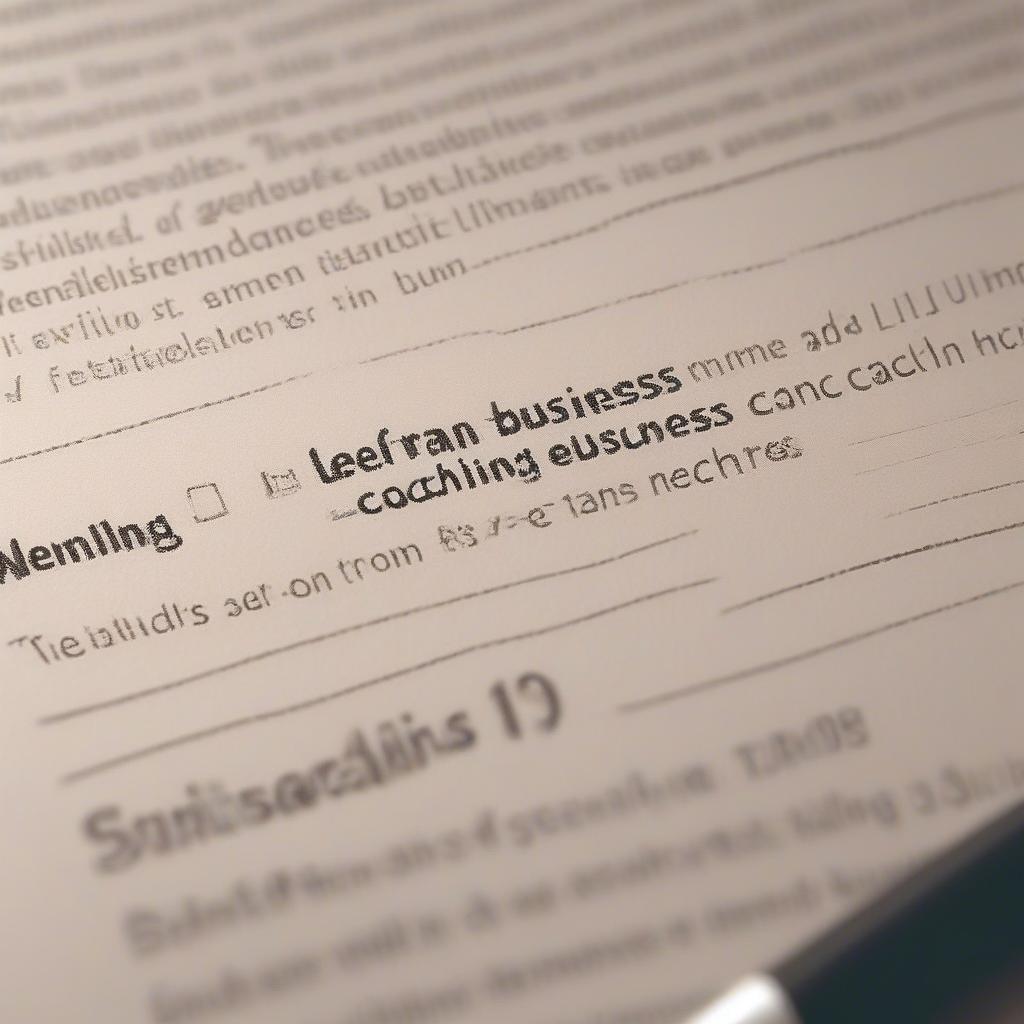
Okay, so you’re a coach. You’re changing lives, empowering individuals, and building a thriving practice. But, let’s be real, the word “taxes” can send a shiver down anyone’s spine, even the most confident business owner. This comprehensive guide aims to demystify the world of coaching taxes, helping you navigate the complexities of business compliance and establish a solid foundation for your financial planning.
Why Taxes Matter for Your Coaching Business
Ignoring taxes is like ignoring the oil in your car – you might get away with it for a while, but eventually, things will grind to a halt. For a coaching business, understanding and managing taxes is not just about avoiding penalties; it’s about:
- Ensuring Long-Term Viability: Proper tax planning allows you to accurately budget and project your cash flow, ensuring the sustainability of your coaching business.
- Protecting Your Personal Assets: Understanding business structures and their impact on your personal liability is crucial. This knowledge can help safeguard your personal finances from business-related risks.
- Maximizing Profitability: By strategically managing expenses and deductions, you can legally minimize your tax burden, increasing your profitability.
- Maintaining a Clean Record: Compliance with tax laws is vital for maintaining a good reputation and avoiding costly audits and legal issues.
- Building Credibility: Clients and partners perceive a business that handles its finances responsibly as more trustworthy and reliable.
Understanding Your Business Structure and Its Tax Implications
The first step in tackling coaching taxes is understanding your business structure. The structure you choose significantly impacts your tax obligations and personal liability. Here are the most common structures and their implications:
Sole Proprietorship
- What it is: The simplest structure, where the business is owned and run by one person, and the business isn’t separate from the owner.
- Tax Implications: Profits and losses are reported on your personal tax return (Form 1040). You’ll pay self-employment tax (Social Security and Medicare) in addition to income tax.
- Pros: Easy and inexpensive to set up, minimal paperwork, full control over the business.
- Cons: No legal protection for personal assets; you are personally liable for business debts and lawsuits.
- Best for: New coaches just starting out, side hustles, low-risk coaching practices.
Partnership
- What it is: A business owned by two or more people who agree to share profits and losses.
- Tax Implications: Similar to sole proprietorships, partners report their share of profits and losses on their individual tax returns. Partnerships also need to file an information return (Form 1065) with the IRS.
- Pros: Relatively easy to set up, shared workload and resources, brings diverse skills and expertise.
- Cons: Partners are typically jointly and severally liable for business debts and lawsuits, potential for disagreements among partners.
- Best for: Coaches working together in a collaborative practice.
Limited Liability Company (LLC)
- What it is: Combines the pass-through taxation of a sole proprietorship or partnership with the liability protection of a corporation.
- Tax Implications: Profits and losses are passed through to the owner’s personal tax return. You can choose to be taxed as a sole proprietor (single-member LLC), partnership (multi-member LLC), S-Corporation, or C-Corporation.
- Pros: Personal liability protection, flexibility in tax options, enhanced credibility.
- Cons: More complex to set up than sole proprietorships or partnerships, possible state franchise taxes.
- Best for: Coaches looking for liability protection, scaling or growing, looking for tax flexibility.
S-Corporation (S-Corp)
- What it is: A corporation that elects to pass its income through to its owners and not pay corporate income tax.
- Tax Implications: Owners (shareholders) are taxed on their share of the corporation’s profits, similar to a partnership. They can also be employees and receive wages, potentially reducing self-employment tax.
- Pros: Potential tax savings on self-employment tax through salary payment, enhanced credibility.
- Cons: More complex to set up and maintain, requires more administrative work than an LLC.
- Best for: Established coaching businesses with significant revenue and the desire to reduce self-employment tax.
C-Corporation (C-Corp)
- What it is: A more complex business structure that is taxed separately from its owners.
- Tax Implications: The corporation pays corporate income taxes, and owners pay taxes on dividends they receive. This is referred to as “double taxation.”
- Pros: Strong liability protection, can raise capital more easily, benefits and deductions for employees.
- Cons: Double taxation (at the corporate level and again when dividends are paid to owners), more complex and expensive to set up and maintain.
- Best for: Coaching businesses planning to become public or raise significant investments, not ideal for most solo coaches or small partnerships.
Actionable Tip: Consult with a tax professional or accountant to determine the most appropriate business structure for your specific circumstances and long-term goals. They can help you make informed decisions and avoid costly mistakes down the line.
Mastering the Art of Self-Employment Taxes for Coaches
As a coach, you’re likely considered self-employed, which comes with unique tax obligations. Understanding the nuances of self-employment tax is crucial for proper financial planning. Here’s what you need to know:
Self-Employment Tax: The Breakdown
Self-employment tax consists of Social Security and Medicare taxes. These are usually split between the employer and employee. As a self-employed individual, you pay both portions, which can seem daunting. For 2023, this is 15.3% (12.4% for Social Security and 2.9% for Medicare) on the first $160,200 of earnings and 2.9% for Medicare.
Estimated Taxes: Paying as You Go
Unlike traditional employees who have taxes withheld from their paychecks, self-employed coaches are required to make quarterly estimated tax payments throughout the year. This prevents a large tax bill at the end of the year and potential penalties.
How to Calculate Estimated Taxes:
- Estimate your annual income: Project your revenue and expenses for the entire year.
- Calculate your estimated taxable income: Subtract your estimated deductions and expenses from your estimated revenue.
- Determine your estimated tax liability: Use your estimated taxable income to calculate income tax, plus self-employment tax using the 15.3%.
- Divide your total estimated tax liability by four: This will give you your quarterly payment amount.
Example: Let’s say your estimated annual taxable income is $60,000. After calculating both your income tax and self-employment tax (including the 15.3%), you determine you owe $12,000. Your quarterly estimated tax payments would be $3,000 each.
When are Estimated Taxes Due?
- April 15: For the period of January 1st to March 31st.
- June 15: For the period of April 1st to May 31st.
- September 15: For the period of June 1st to August 31st.
- January 15 of the following year: For the period of September 1st to December 31st.
Actionable Tip: Set reminders for your estimated tax due dates. Using a tax software or working with a professional can simplify the calculation process. Overpaying is better than underpaying, as this helps you avoid penalties and interest.
The Importance of Tracking Income and Expenses
Accurate record-keeping is paramount for managing coaching taxes. You’ll need this information when filing your taxes and determining your eligibility for deductions.
Tips for Tracking Your Finances:
- Separate Business and Personal Accounts: This is essential for clarity and makes it easier to track your income and expenses.
- Utilize Accounting Software: Use accounting software such as QuickBooks, Xero or Wave to automate your financial tracking process.
- Document Everything: Keep receipts for all business-related expenses, and maintain records of your income and invoices.
- Schedule Regular Reviews: Regularly review your financial records to catch errors and make sure you’re on track with your budget.
Maximizing Tax Deductions for Your Coaching Business
One of the most effective ways to minimize your tax burden is to take advantage of legitimate business deductions. Knowing what expenses you can deduct will make a huge difference in your financial planning.
Common Deductible Expenses for Coaches:
- Home Office: If you use a portion of your home exclusively and regularly for your business, you can deduct a portion of your rent or mortgage, utilities, and other related expenses.
- Equipment: Computers, printers, office furniture, and other equipment used for your business.
- Software and Subscriptions: Coaching platforms, scheduling software, accounting software, and other online tools.
- Marketing and Advertising: Website design, social media ads, promotional materials, and other marketing costs.
- Business Insurance: Professional liability insurance, general liability insurance, etc.
- Professional Development: Coaching certifications, training programs, industry conferences.
- Travel Expenses: If you travel for business purposes, you can deduct transportation, accommodation, and meals.
- Legal and Professional Fees: Fees paid to attorneys, accountants, and consultants.
- Business Meals: Meals with clients or business contacts (subject to certain limitations).
Actionable Tip: Keep thorough records of all business expenses, including receipts, invoices, and bank statements. Consult with a tax professional to ensure you are claiming all eligible deductions.
Understanding the Home Office Deduction:
The home office deduction can be a substantial tax saver, but there are some strict criteria:
- Exclusive Use: The space must be used exclusively for business purposes.
- Regular Use: The space must be used regularly for your business.
- Principal Place of Business: It must be your primary location of your coaching practice.
There are two methods to calculate the home office deduction:
- Simplified Option: A standard deduction of $5 per square foot of your home office (maximum of 300 square feet).
- Regular Method: Requires calculating the percentage of your home used for business and applying that percentage to your eligible home expenses.
Actionable Tip: Choose the method that offers the greatest tax savings for you. Keep detailed records of the dimensions of your home office and all relevant expenses.
Business Compliance and Keeping Your Coaching Business in Check
Beyond taxes, business compliance involves adhering to various legal and regulatory requirements. Neglecting these obligations can lead to fines, penalties, and even legal problems.
Key Compliance Areas for Coaches:
- Business Licenses and Permits: Check your state and local requirements for obtaining necessary licenses and permits.
- Contracts and Agreements: Have clear contracts with clients outlining your services, fees, and cancellation policies.
- Data Privacy: Comply with data privacy regulations, such as GDPR (if you have clients in the EU) and state laws regarding the use and storage of personal information.
- Intellectual Property: Protect your coaching materials and content with proper copyright and trademark registrations.
- Business Insurance: Ensure you have adequate liability coverage to protect yourself and your business.
- Industry-Specific Regulations: Be aware of any regulations that apply specifically to the coaching profession.
Actionable Tip: Consult with a legal professional to ensure you are meeting all relevant compliance requirements. Regularly review your policies and procedures to stay up-to-date with changes in the law.
Financial Planning Beyond Taxes for Coaching Businesses
Financial planning isn’t just about filing taxes; it’s about creating a secure financial future for your coaching business.
Essential Financial Planning Steps:
- Create a Budget: Develop a detailed budget that outlines your income, expenses, and savings goals.
- Set Financial Goals: Define clear and measurable financial goals, such as paying off debt, saving for retirement, or making investments.
- Monitor Your Cash Flow: Track your income and expenses regularly to ensure that you have adequate cash on hand to meet your obligations.
- Build an Emergency Fund: Establish an emergency fund to cover unexpected expenses and business downturns.
- Plan for Retirement: Start saving for retirement as early as possible to ensure a comfortable future.
- Seek Professional Advice: Consult with a financial advisor or planner to create a comprehensive financial plan that aligns with your goals.
Actionable Tip: Review your financial plan regularly to make adjustments as needed and to ensure you’re on track to reach your objectives.
Learn Business: Your Partner in Coaching Success
Navigating the complexities of taxes and business compliance can be overwhelming for coaches. This is where Learn Business comes in. We understand the unique challenges that coaching businesses face, and we provide comprehensive support to help you thrive.
How Learn Business Supports Coaching Businesses:
- Customized Guidance: We offer personalized guidance tailored to your specific coaching niche, structure, and financial goals.
- Template Library: Access our extensive library of business templates including:
- Client Contracts
- Invoice Templates
- Budget Templates
- Tax Deduction Trackers
- Financial Planning Spreadsheets
- Expert Advice: Benefit from the expertise of our team of business advisors, tax professionals, and financial planners.
- Workshops and Webinars: Participate in our workshops and webinars to learn about the latest best practices in business management, tax optimization, and financial planning.
- Community Support: Connect with a supportive community of like-minded coaches and entrepreneurs, sharing your questions, experiences and strategies.
- On-demand learning modules: Covering all aspects of running a successful business.
Learn Business provides the tools, resources, and support you need to confidently manage your coaching business and achieve your financial goals.
Conclusion: Taking Control of Your Coaching Business Finances
Managing coaching taxes, ensuring business compliance, and building a solid financial plan are not just about ticking off boxes. It’s about creating a sustainable and prosperous future for your coaching business. By understanding the principles discussed in this guide, taking the time to set up robust processes, tracking your finances accurately, and leveraging the resources available to you (like Learn Business), you can confidently navigate these important areas. You’re not just a coach; you’re a business owner. By mastering your finances, you’ll unlock your potential to thrive and make an even greater impact. Remember, knowledge is power, and taking charge of your financial well-being sets you up for true success. You’ve got this!



Leave a Reply